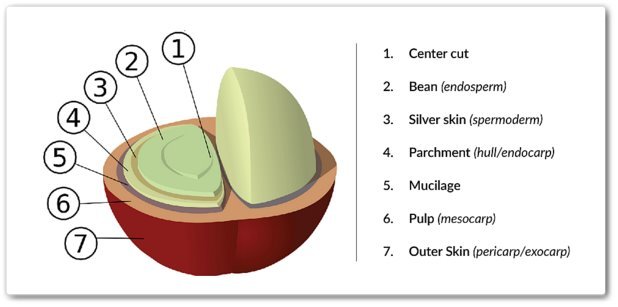Wet milling – how to get washed coffee
We have talked about the coffee chain. If roasting coffee is the most interesting and scientific part of the chain after leaving the farm, wet milling is definitely the most interesting and difficult part on the farm. Seed selection, maintenance, water supply, fertilizing etcetera are very difficult processes when talking about coffee in the field but I personally am really intrigued with the process of wet milling, it is one of the key processes of producing quality coffee.
Let’s take a look at the typical process of wet milling at a small producer’s farm in Central America. The process actually starts with harvesting. Harvest time can take a month or two because not all the cherries ripen at the same time and to guarantee a successful milling, only the ripe (red) cherries should be collected. Red cherries are composed of 40% pulp, 16% mucilage, 4% husk, 20% water and only 20% green coffee.

Wet milling requires that fresh water is (abundantly) available, but our small farmer is trained in the “ecological” way of doing things, so he tries to keep water consumption at a low level. He pours the harvested cherries in a barrel or a bucket to “float” the cherries. This way he softens the outer husk and pulp, cleans the cherries and selects the coffee. Leaves, twigs and unripe, green cherries and even cherries with vain or damaged beans start floating, and he takes them out thus leaving only the red ripe ones and protecting his milling machine at the same time.
As the cherries are already softened and still wet, he does not need to pour water on them as they are run through his pulping machine removing the husk and pulp from the parchment covered beans. He’s thinking about his neighbor who does not float: “He uses about 10 to 20 times as much water and always is fiddling around with his pulping machine that was damaged milling twigs and green beans and always crushes the good ones …. He’ll get paid less for his coffee, so maybe someday he will reconsider?”
He collect the pulp, because he is going to use it as a natural fertilizer. He build a box to collect the pulp and make fertilizer for his nursery and other boxes to feed worms with the pulp to obtain humus. He has heard that that organic fertilizer works great and can be sold at a nice profit as well.
The milled beans, still covered in their silver skin, are sorted by weight via his wooden water channel and led to some concrete tanks where they are covered with water. Sitting in these tanks for 12 to 48 hours (depending on weather conditions) a fermentation process starts. Our small farmer knows that this is a critical point in the process because a bad fermentation can ruin the quality of his coffee. He is a bit worried because he has to oversee harvest and fermentation at the same time! Fermentation makes the layer of mucilage (parenchyma) that is attached to the parchment soft and it separates it, but as soon as it is ready he has to wash it away in some wooden canals. The only reliable way to see if fermentation is done is to put a stick into the tank and see if it leaves a nice round hole .. He collected some mucilage before and will use it if he wants to speed up the fermentation process.
The resulting, dirty, water is led to 3 cascading basins. From the first he collects some to use as insecticide. Each tank filters the “agua miel” (honey water) a bit more and, just to show off to his neighbors, he dug a 4th hole where he started to keep fishes before leading the remaining water to the river. He is not going to pollute the small river that gives life to this mountain and everybody beyond.
Now he only has to dry the parchment coffee a bit in the sun, and then off to the cooperative with his washed coffee, so it can be dry milled!
Previous article from coffee series you can find under tag #cafescope.
You can see them all here.
Article was also published on Cafescope
You got a 64.90% upvote from @slimwhale courtesy of @petrvl!
This post has received a 0.16 % upvote from @drotto thanks to: @petrvl.
Very interesting post. Now when I will drink the coffee I will think about the process as well.
Dík :)
You got a 2.18% upvote from @upme thanks to @petrvl! Send at least 3 SBD or 3 STEEM to get upvote for next round. Delegate STEEM POWER and start earning 100% daily payouts ( no commission ).
You got a 3.85% upvote from @brupvoter courtesy of @petrvl!